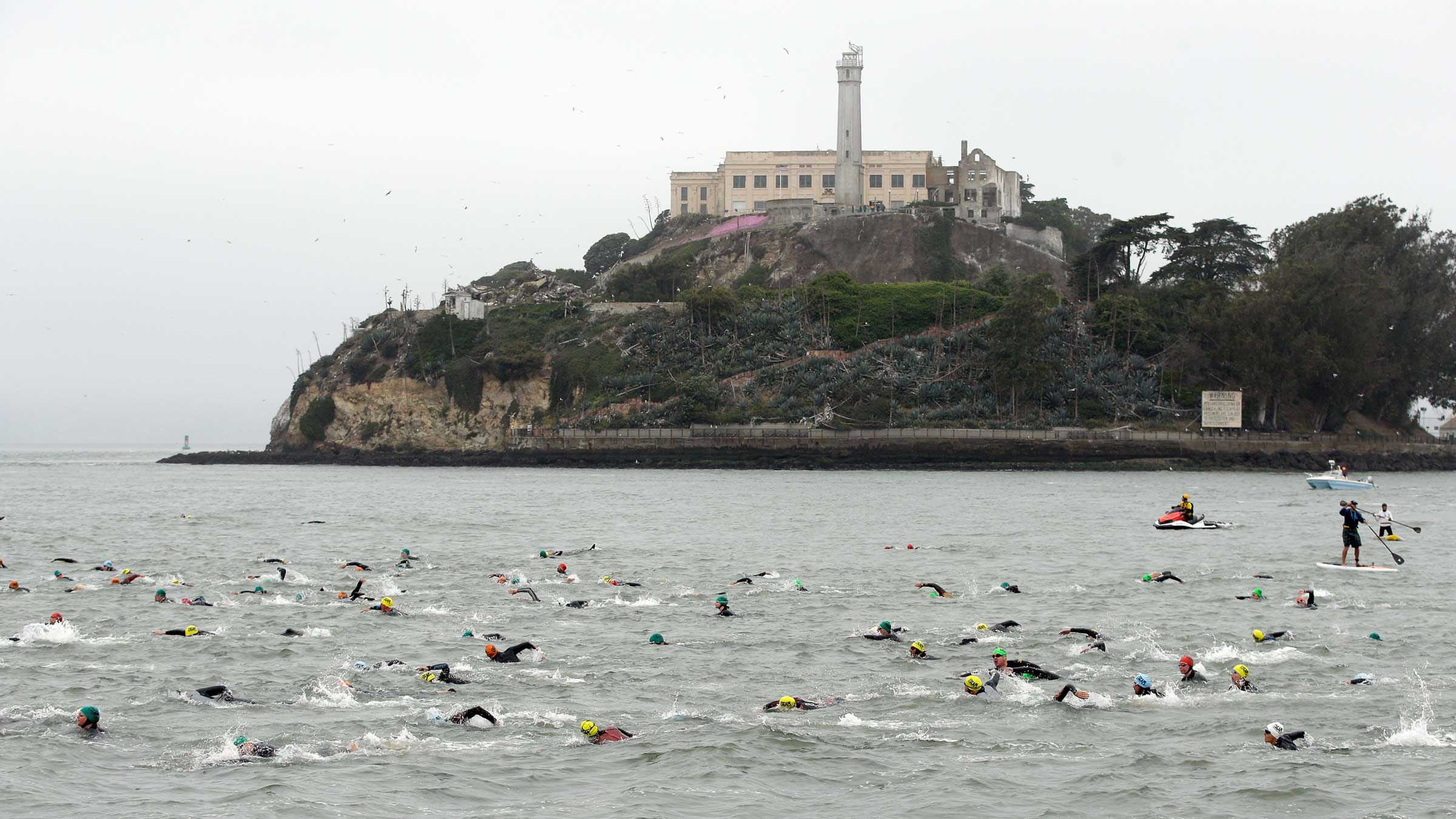Recalled: A Look Back At the First Escape From Alcatraz Triathlon

Athletes compete in the 2014 Escape From Alcatraz triathlon. (Photo: Ezra Shaw)
Before it became the basis for a legendary triathlon, the notion of “escaping from Alcatraz” was saved for jailbirds breaking free from the penitentiary built on an impenetrable island in 1934 to house some of the most notorious criminals. While many prisoners attempted to flee “the Rock,” just three are said to have survived the harrowing swim across the swift-moving and frigid (and rumored to be shark-infested) San Francisco Bay.
It’s those same choppy, chilly waters that thousands of triathletes have thrown themselves into for the past four decades; not to flee from jail, of course, but simply for sport. What began as San Francisco’s answer to Hawaii’s grueling Ironman has become a bucket list event that, had it not been canceled for the pandemic, would have celebrated its 40th anniversary on June 7 with guests speakers including the likes of Kenneth Widner, the nephew of John and Clarence Anglin, two prisoners who masterminded their own great Alcatraz escape in 1962. (As of now, event organizers have not announced the 2021 race date).
So how did this race first come to be? Credit goes to Bay Area resident “Alcatraz Joe” Oakes, who, around 1980, proposed the idea of a San Francisco triathlon after racing the Hawaiian Ironman, then held in Honolulu. “I said ‘Hey, we’ve got to do something like that in San Francisco, but not as long and boring and a lot more intense. It will start with a very cold swim from Alcatraz and finish with a run across the mountainous and the notoriously hot Dipsea Trail—twice. I would connect them with a bike ride across the Golden Gate Bridge,’” Oakes told triathlete Scott Tinley in this lengthy piece on the race’s history.
It took two years for the event to get its footing, and, in June 1981, the first Escape from Alcatraz Triathlon field assembled for a 1.5-mile swim, a 20-mile bike, and an 18-mile run. Reportedly, no wetsuits were worn by any competitor, and there was no boat, either. While Escapees are now unloaded from a heated boat, the earliest competitors took off from a rocky, windswept cove on Alcatraz Island and swam towards Aquatic Park. When race organizers noticed that some triathletes were falling off their bikes due to the shock of the cold-water swim, they added a five-minute warm-up run to Fort Mason, an addition that remains today. (Later, when the race was broadcast on NBC for the first time, the course was changed so that it stayed within the confines of San Francisco, and the bike was reduced to 18 miles and the run to 8 miles. The course has remained the same since 1995).
Among the faces in the crowd on that early June morning in 1981 was local Dave Horning, a pioneer on the early pro triathlete scene. He took the lead out of the water and held it, gamely traversing the route that might as well have been his backyard, becoming the first-ever champion of the Escape From Alcatraz Triathlon. Horning would go on to win it again in 1982–and garnered a cover spot on Runner’s World magazine, a book deal, and sponsorships from American Express, Nike, GORE-TEX, and Pan-Am airlines among others as a result of his epic wins.
As for the women? No female finishers were recorded in 1981, but Claire McRae of Massachusetts took the tape in 1982 and 1983. McRae didn’t receive the same insta-fame as Horning did, but she did remain the only multi-time winner until 1991 when Paula Newby Frasier came in and won three times in a row. (However, the indisputable Queen of Alcatraz is Aussie Michellie Jones, who won eight times between 1995 and 2005. On the men’s side, Andy Potts is the winningest, with six victories between 2007 and 2014.)
While rough water, fog, and unfavorable weather have hampered the race in some years (case in point: a canceled swim in 2017 due to a small craft advisory), it took a global pandemic to stall the Escape From Alcatraz Triathlon for the first time in 39 years. Which means this race is as enduring as the athletes who dare to complete it.